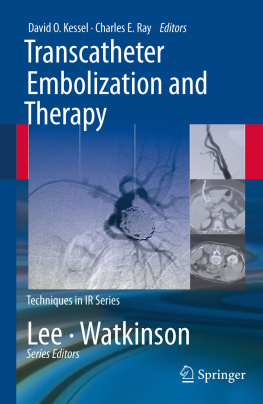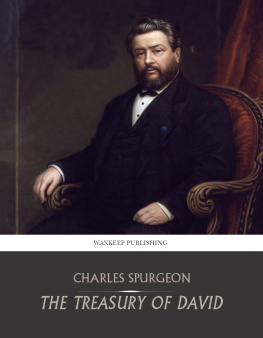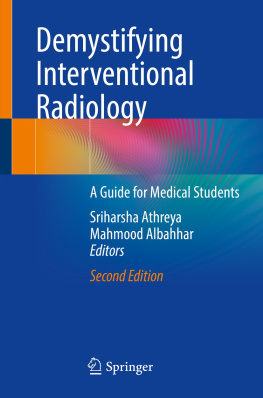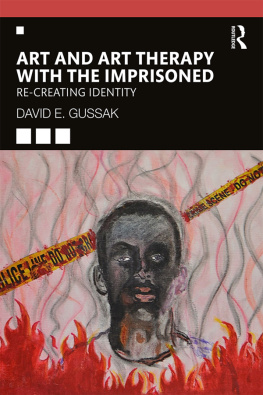David Kessel and Charles Ray - Transcatheter Embolization and Therapy
Here you can read online David Kessel and Charles Ray - Transcatheter Embolization and Therapy full text of the book (entire story) in english for free. Download pdf and epub, get meaning, cover and reviews about this ebook. publisher: Springer London, London, genre: Children. Description of the work, (preface) as well as reviews are available. Best literature library LitArk.com created for fans of good reading and offers a wide selection of genres:
Romance novel
Science fiction
Adventure
Detective
Science
History
Home and family
Prose
Art
Politics
Computer
Non-fiction
Religion
Business
Children
Humor
Choose a favorite category and find really read worthwhile books. Enjoy immersion in the world of imagination, feel the emotions of the characters or learn something new for yourself, make an fascinating discovery.
- Book:Transcatheter Embolization and Therapy
- Author:
- Publisher:Springer London, London
- Genre:
- Rating:3 / 5
- Favourites:Add to favourites
- Your mark:
- 60
- 1
- 2
- 3
- 4
- 5
Transcatheter Embolization and Therapy: summary, description and annotation
We offer to read an annotation, description, summary or preface (depends on what the author of the book "Transcatheter Embolization and Therapy" wrote himself). If you haven't found the necessary information about the book — write in the comments, we will try to find it.
Transcatheter Embolization and Therapy — read online for free the complete book (whole text) full work
Below is the text of the book, divided by pages. System saving the place of the last page read, allows you to conveniently read the book "Transcatheter Embolization and Therapy" online for free, without having to search again every time where you left off. Put a bookmark, and you can go to the page where you finished reading at any time.
Font size:
Interval:
Bookmark:
Section I
- The pathophysiology of the underlying condition
- The role of alternative therapies
- The likely therapeutic outcomes of the various therapies
- The vascular anatomy relevant to the clinical scenario
- The different types of embolic agents and how to use them
- The likelihood of success and recurrence
- The potential to cause and manage adverse events
- target organ dysfunction
- collateral (non-target) embolization
- post-embolization syndrome
- If the pathology has an ongoing tissue-based process (e.g., inflammatory/ neoplastic), then occlusion is required at small vessel/capillary level to achieve a durable result.
- When there is a single stimulus to vessel injury (e.g., post-renal biopsy), then occlusion at arterial level will be enough to produce a durable result, though reperfusion via collateral pathways needs to be considered.
- Embolization may be complementary to other therapies.
- Embolization may be a vital prelude to other therapy (e.g., surgery).
- Embolization may be the only viable therapy.
- Embolization may not be the optimal therapy.
- Often common sense will direct you to the appropriate vascular distribution. In the example above, bleeding following renal biopsy will originate from the corresponding renal arterial branches.
- When the situation is not so obvious (e.g., gastrointestinal hemorrhage), then cross-sectional imaging will commonly identify the site of bleeding. This will often direct angiographic interrogation.
- Most proximal arterial variations can be identified by careful interpretation of CT angiography.
- CT will not always identify the vessel of origin. For example, bleeding into the retroperitoneum can come from a large number of adjacent vesselsand some work will still be required at angiography!
- In general, even with the advent of CT and MR angiography, it is always better to start by establishing the arterial anatomy with overview (non-selective) angiography.
- In some vascular territories (e.g., the visceral circulation), variant anatomy will be present in over a quarter of cases. Subtle arterial variations are still best appreciated at selective angiography. Only after the anatomy has been established should the operator proceed to more selective catheterization of the target vessel.
- Collateral pathways are a mixed blessing for embolization therapy. While in some circumstances the existence of a collateral pathway can prevent tissue ischemia after embolization, the same network of pathways may continue to perfuse a target lesion beyond embolization coils.
- The classic collateral pathway of the gastroduodenal artery (Fig.) is a perfect illustration. A lesion in the mid gastroduodenal artery cannot be successfully treated by proximal embolization of the common hepatic artery or even the gastroduodenal artery alone. The lesion will continue to be supplied via the superior mesenteric artery/inferior pancreaticoduodenal arcade.
Font size:
Interval:
Bookmark:
Similar books «Transcatheter Embolization and Therapy»
Look at similar books to Transcatheter Embolization and Therapy. We have selected literature similar in name and meaning in the hope of providing readers with more options to find new, interesting, not yet read works.
Discussion, reviews of the book Transcatheter Embolization and Therapy and just readers' own opinions. Leave your comments, write what you think about the work, its meaning or the main characters. Specify what exactly you liked and what you didn't like, and why you think so.











